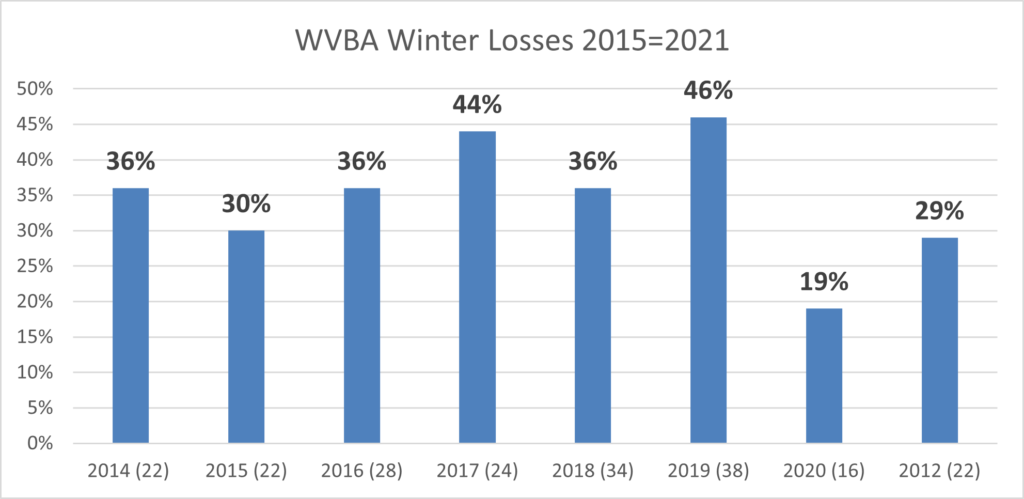WVBA members were encouraged to complete a web-based survey document in a continuing effort to define overwintering losses/successes of backyard beekeepers in Oregon. This was the 12th year of such survey activity. I received 368 responses from OR backyarders, keeping anywhere from 1 to 40 colonies; Willamette Valley members sent in 22 surveys, 6 more than last year, reporting on 168 fall colonies.
Overwintering losses of WVBA respondents =29 %, the 2nd best record of OR clubs. Percent losses, determined by hive types were 29% for both Langstroth 8 and 10 frames hives (=86% of total number of hives) and 23% loss of nucs (only 14 reported by respondents). Of 6 top bar hives, 3 were lost, a single Warre hive was lost and a single styrofoam hive survived.
The survey also asked for hive loss by hive origination. The members reported 14% loss of previously overwintered colonies, a heavy 75% loss of the 8 packages, while nuc (54%) and swarm (44%) losses were intermediate. Most impressive was only a 9% loss of 35 splits.
Average winter losses of WVBA members was the 2nd lowest of past 7 years. The attached figure shows WVBA losses for past 8 years. The number below the year in ( ) is the number of survey respondents for the year.
Typical of the statewide data, the WVBA respondents are largely new beekeepers. 50% of WVBA respondents had 1 to 3 fall colonies whiel8 respondents (32%) had 10+ colonies – maximum number for any respondent was 26 colonies. Not everyone had loss. Seven WVBA individuals (32%) reported total winter survival; and equal number had 100% winter loss of colonies.
Reasons for Colony Loss/Acceptable loss
We asked of individuals that had colony loss to estimate what the likely reason(s) might have been, Multiple responses were permitted. Nine individuals (60%) of those having losses said Varroa mites. 33% said weak in fall, 4 individuals each said poor winter conditions and starvation and 3 20% said queen issues.
Why colonies die?
There is no easy way to verify reason(s) for colony loss. Colonies in the same apiary may die for different reasons. Examination of dead colonies is, at best confusing, and, although some options may be ruled out, we are often left with two or more possible reasons for losses. There is a good deal of variance in opinion as to what might be an acceptable loss level. We are dealing with living animals which are constantly exposed to many different challenges, both in the natural environment and the beekeeper’s apiary.
Major factors in colony loss are mites and their enhancement of viruses especially DWV (deformed wing virus) and declining nutritional adequacy/forage and diseases. Pesticide exposure in the agricultural environment weakens colonies. Yellow jacket predation is a constant danger to weaker fall colonies, Management, especially learning proper bee care in the first years of beekeeping, remains a factor in losses. What effects our changing environment such as global warming and other factors, play in colony losses are not at all clear. There is no simple answer to explain the levels of current losses nor is it possible to demonstrate that they are necessarily excessive for all the issues facing honey bees in the current environment.
Management selections and losses
I will be preparing a report of how managements affected winter losses similar to earlier years. A full report will be posted to pnwhoneybeesurvey.com for the state respondents along with a WVBA individual club report when that analysis is completed. I thank all WVBA members who sent in a report. Please get in touch directly if you have questions or comments. dmcaron@udel.edu

